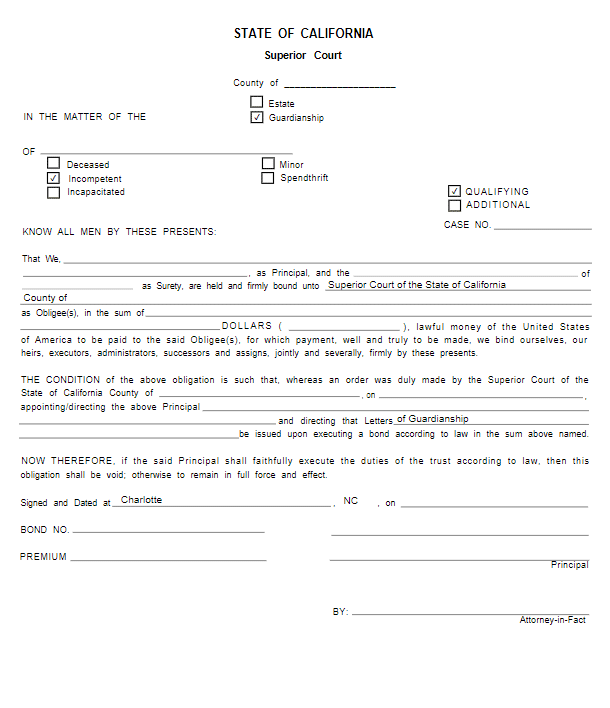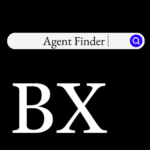California Conservator Bond: A Comprehensive Guide
This guide provides information for insurance agents to help their customers obtain a California Conservator bond. For information on the bonding requirements for Guardians in California, click here.
At a Glance:
- Average Cost: Calculated based on a tiered structure
- Bond Amount: Determined on a case-by-case basis (more on this later)
- Who Needs It: Most conservators appointed as fiduciaries in California
- Purpose: To ensure the conservatee receives compensation for financial harm if the conservator mishandles their estate
- Who Regulates Conservator Bonds in California: The superior court of the county where the conservatee resides or has property

Background
California Probate Code 1801 requires all persons seeking conservatorship over a conservatee to be appointed as a fiduciary by the superior court of the county where the conservatee resides. The California legislature enacted the appointment requirement to ensure that conservators act in the conservatee’s best interests when managing their estate. To provide financial security for the enforcement of this requirement, most conservators must purchase and maintain a probate surety bond before becoming appointed as a fiduciary.
What is the Purpose of the California Conservator Bond?
California requires most conservators to purchase a surety bond as a prerequisite to being appointed as a fiduciary over a conservatee’s estate. The bond ensures that the conservatee and all persons interested in the conservatee’s estate will receive compensation for financial harm if the conservator fails to abide by the regulations outlined in Article 3 of the California Probate Code. Specifically, the bond protects the conservatee if the conservator fails to adhere to all court orders or mismanages the estate’s assets. In short, the bond is a type of insurance that protects the conservatee if the conservator does not fulfill their fiduciary duties.
How Can an Insurance Agent Obtain a California Conservator Bond?
BondExchange makes obtaining a California Conservator bond easy. Simply log-in to your account and use our keyword search to find the “Conservator” bond in our database. Don’t have a login? Gain access now and let us help you satisfy your customers’ needs. Our friendly underwriting staff is available by phone (800) 438-1162, email or chat from 7:30 AM to 7:00 PM EST to assist you.
At BondExchange, our 40 years of experience, leading technology, and access to markets ensures that we have the knowledge and resources to provide your clients with fast and friendly service whether obtaining quotes or issuing bonds.
Not an agent? Then let us pair you with one!

Click the above image to find a BX Agent near you
How is the Bond Amount Determined?
California Probate Code 2320 dictates that the bond amount must be equal to the aggregate value of the estate’s personal property plus the estimated gross income to be generated by the estate over the next year and any of the conservatee’s public entitlements. California Rules of Court 7.207 dictates that the estimated costs to file a claim against the bond must be added to the bond amount.
The bond amount may be reduced by the value of any property deposited with a trust company or financial institution that can not be withdrawn without a court order.
Can the Bond Amount be Adjusted?
Yes, as California Probate Code 2321 permits the superior court to adjust the required bond amount as they see fit. Conservators can petition the court to reduce the required bond amount. The court may require the conservator to furnish an additional bond if:
- The conservatee’s real property is sold or a mortgage is taken on the conservatee’s real property
- The current bond amount becomes insufficient
What are the Underwriting Requirements for the California Conservator Bond?
Most surety companies will examine the following factors when determining eligibility for the California Conservator bond:
- Conservator’s credit history
- Whether or not the estate has an attorney
- Whether or not the conservator is a family member
- The conservator’s occupation
- Whether or not the conservator is replacing a prior fiduciary
- If the conservator has ever committed a felony
- Whether or not there is any ongoing business in the estate
- If a creditor is requiring the bond
- If the bond amount is greater than or equal to the estate’s value
How Much Does the California Conservator Bond Cost?
Surety companies typically determine the premium rate for Conservator bonds based on a tiered structure, so larger bond amounts will be charged a lower premium rate than smaller bonds.
The following table illustrates the pricing structure for the California Conservator bond:
$1,500,000 Conservator Bond Cost
| Bond Amount | Premium Rate | Total Bond Cost |
|---|---|---|
| First $20,000 | 0.75% | $150 |
| Next $40,000 | 0.60% | $240 |
| Next $140,000 | 0.50% | $700 |
| Next $300,000 | 0.375% | $1,125 |
| Next $1,000,000 | 0.25% | $2,500 |
| Total cost of $4,715 |
Who is Required to Purchase the Bond?
California requires most conservators to purchase a surety bond as a prerequisite to becoming a court-appointed fiduciary. To paraphrase the California Judicial Branch, a conservator is an individual or organization appointed as a fiduciary to act or make decisions over a conservatee’s person and/or estate. There are two different types of conservatorships:
- General Conservatorship: A conservator who has all powers and responsibilities over a conservatee, except ones found unnecessary by the court
- Limited Conservatorship: A conservatorship where powers are strictly limited up to seven specific powers based on the needs of the conservatee
Additionally, a “conservatee” is defined as an adult for whom a conservator has been appointed that is incapable of making sound decisions concerning the wellbeing of their person and/or estate. Conservators are not required to purchase a surety bond, unless explicitly required by the court, in the following situations:
- The conservatorship is only for the conservatee’s person, not the estate
- If the estate has a total net value of less than $15,000, a monthly income of less than $2,000, and all spent income of the estate is for the benefit of the conservatee

How do California Conservators Become Appointed as Fiduciaries?
Conservators in California must navigate several steps to become appointed as fiduciaries. Below are the general guidelines, but appointees should refer to the appointment statutes or the California Judicial Branch’s website for details on the process.
Step 1 – Determine if a Conservatorship is Needed
Before starting the conservatorship process, persons seeking conservatorship must first determine the size of the conservatee’s estate. Generally, a conservatee’s estate could fall under the following three scenarios:
-
- No Estate: The conservatee receives only public benefits as income and owns no substantial assets outside of their place of residence.
- Small Estate: The conservatee receives up to $2,000/month in income and has no more than $15,000 in assets excluding their residence
- Estate: The conservatee has a monthly income exceeding $2,000/month and owns more than $15,000 in assets
If a conservatee has no estate or a small estate, conservators are not required to obtain a bond. If the conservatee has a monthly income exceeding $2,000 and a net worth exceeding $15,000, a conservatorship of the estate and a conservator bond will likely be required.
Step 2 – Determine Priority
Priority to serve as a conservator is granted in the following order:
-
- The person preferred by the conservatee
- The person preferred by the prior conservator
- The spouse or partner of the conservatee or their nominee
- The adult child of the conservatee or their nominee
- The parent of the proposed conservatee or their nominee
- The sibling of the proposed conservatee or their nominee
- Any other person eligible for appointment as a conservator
Step 3 – Hire an Attorney
Although not explicitly required, it is highly recommended that conservators hire an attorney to assist with the conservatorship process.
Step 4 – File All Required Forms
Persons seeking a conservatorship must file multiple forms with the superior court of the county where the person resides. Conservators can obtain the forms online here or from the court, and can file them by mail or in person at the courthouse.
Conservators can utilize the free Self-Help Center available at every county court for assistance in the filing process and to ensure they complete the process accurately. Most counties assess a fee, typically $435, to begin the process, and conservators can submit a fee waiver if qualified.
Step 5 – Notify the Appropriate Parties
After submitting the appropriate files to the court, persons seeking conservatorship must have another adult, known as a server, notify the following parties in person:
-
- The proposed conservatee
- The proposed conservatee’s relatives, including their spouse, parents, children, and grandchildren
- The Regional Center where the adult receives disability services
The notice must be served in person to the proposed conservatee and served by mail to the remaining parties. Conservators must file a proof of service after providing notice and can learn more about the notice process online here.
Step 6 – Complete the Investigation
The court will appoint an investigator to conduct an interview with the conservator to determine if the conservatorship is necessary. The interviewer will submit a report with recommendations to be used in the hearing (more on this in Step 4). The investigator will also interview the proposed conservatee and may interview their relatives if necessary.
Step 7 – Attend a Hearing
Conservators must attend a hearing conducted by the superior court of the county where the conservatee resides and present evidence as to why the adult is in need of conservatorship. The court will examine the evidence presented by the conservator as well as that presented by the adult being evaluated (if any) and make a determination as to whether or not conservatorship is necessary.
Any interested person can apply to the court to participate in the hearing. If the court finds a basis for the appointment, it will issue a letter of conservatorship to the petitioner.
Step 8 – Purchase a Surety Bond
Unless otherwise exempt, conservators must purchase and maintain a surety bond (limits outlined above).
How do California Conservators File Their Bonds?
Conservators should submit their completed bond forms, including the power of attorney, to the superior court of the county where the conservatee resides.
The surety bond requires signatures from both the surety company that issues the bond and the applicant. The surety company should include the following information on the bond form:
- Case number
- Legal name and county of the conservatee
- Legal name of the entity/individual(s) buying the bond
- Surety company’s name
- Date the conservator is appointed
- Type of fiduciary relationship
- Bond amount and bond premium
- Date the bond is signed
What can California Conservators do to Avoid Claims Made Against Their Bonds?
To avoid claims against their bonds, conservators in California must ensure that they:
- Perform all of their fiduciary duties
- Obey all court orders
- Do not mismanage the conservatee’s assets
